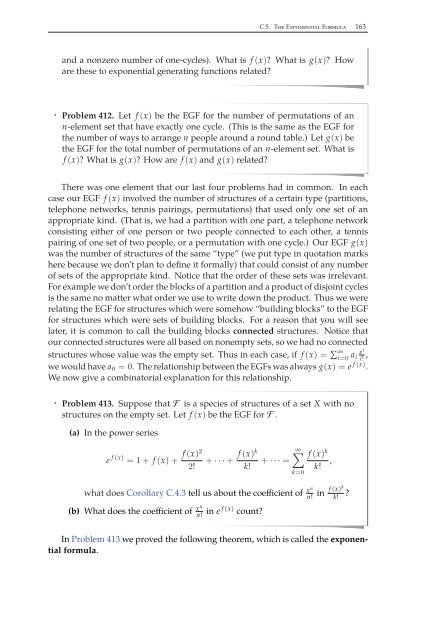Combinatorics Through Guided Discovery, 2004a
Combinatorics Through Guided Discovery, 2004a
Combinatorics Through Guided Discovery, 2004a
Create successful ePaper yourself
Turn your PDF publications into a flip-book with our unique Google optimized e-Paper software.
C.5. The Exponential Formula 163<br />
and a nonzero number of one-cycles). What is f (x)? What is g(x)? How<br />
are these to exponential generating functions related?<br />
· Problem 412. Let f (x) be the EGF for the number of permutations of an<br />
n-element set that have exactly one cycle. (This is the same as the EGF for<br />
the number of ways to arrange n people around a round table.) Let g(x) be<br />
the EGF for the total number of permutations of an n-element set. What is<br />
f (x)? What is g(x)? How are f (x) and g(x) related?<br />
There was one element that our last four problems had in common. In each<br />
case our EGF f (x) involved the number of structures of a certain type (partitions,<br />
telephone networks, tennis pairings, permutations) that used only one set of an<br />
appropriate kind. (That is, we had a partition with one part, a telephone network<br />
consisting either of one person or two people connected to each other, a tennis<br />
pairing of one set of two people, or a permutation with one cycle.) Our EGF g(x)<br />
was the number of structures of the same “type” (we put type in quotation marks<br />
here because we don’t plan to define it formally) that could consist of any number<br />
of sets of the appropriate kind. Notice that the order of these sets was irrelevant.<br />
For example we don’t order the blocks of a partition and a product of disjoint cycles<br />
is the same no matter what order we use to write down the product. Thus we were<br />
relating the EGF for structures which were somehow “building blocks” to the EGF<br />
for structures which were sets of building blocks. For a reason that you will see<br />
later, it is common to call the building blocks connected structures. Notice that<br />
our connected structures were all based on nonempty sets, so we had no connected<br />
structures whose value was the empty set. Thus in each case, if f (x) = ∑ ∞<br />
i=0 a i xi<br />
i! ,<br />
we would have a 0 =0. The relationship between the EGFs was always g(x) =e f (x) .<br />
We now give a combinatorial explanation for this relationship.<br />
· Problem 413. Suppose that F is a species of structures of a set X with no<br />
structures on the empty set. Let f (x) be the EGF for F .<br />
(a) In the power series<br />
e f (x) =1+ f (x)+ f (x)2<br />
2!<br />
+ ···+ f (x)k<br />
k!<br />
+ ···=<br />
∞∑<br />
k=0<br />
f (x) k<br />
,<br />
k!<br />
what does Corollary C.4.3 tell us about the coefficient of xn<br />
n!<br />
(b) What does the coefficient of xn<br />
n! in e f (x) count?<br />
in<br />
f (x)k<br />
k!<br />
?<br />
In Problem 413 we proved the following theorem, which is called the exponential<br />
formula.


















